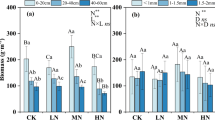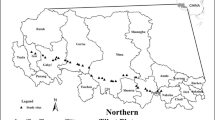Abstract
A difference in the adaptation of plants to rich and poor soils is observed at the intraregional level. The nitrogen and carbon content in fine roots and its relation to the taxonomic position and ecologo-morphological traits of a plant has been studied in 92 alpine plant species of the northwestern Caucasus. The nitrogen content varies from 0.43% (Bromus variegates) to 3.75% (Corydalis conorhiza), with the mean value equal to 1.3%. The carbon content varies from 40.3% (Corydalis conorhiza) to 51.7% (Empetrum nigrum), with the mean value equal to 43.4%. The average C: N ratio in fine roots is 34: 1, which is higher than the same value observed in other regions. Roots of dicotyledons have a higher nitrogen content than those of monocotyledons. The highest and lowest values of this parameter are observed in Fabaceae (2.1%) and Poaceae (1.3%), respectively. The highest and lowest carbon concentrations were observed in roots of Ericaceae (47.2%) and Ranunculaceae (42.1%), respectively. Among the species studied, the carbon content in roots increases in the following order: geophytes < hemicryptophytes < chamephytes. The specific root length positively and negatively correlates with the nitrogen and carbon content in roots, respectively. Large-leaved species, which have a higher specific leaf area, are characterized by higher nitrogen and lower carbon content in their roots. The content of nitrogen and carbon in fine roots positively correlates with their content in leaves. This fact confirms the association between the ecologo-morphological traits of plants and the chemical composition of their fine roots. Plant species with a higher growth rate are characterized by a higher nitrogen and lower carbon content in their roots; they are also characterized by the arbuscular mycorrhyza, a higher seed production, and larger leaves with a higher water content and a higher specific leaf area. These traits correspond to the plants of the competitive and ruderal strategies. On the other hand, stress-tolerant (patient) plants with adaptations to low nutrient levels and low growth rate are characterized by higher carbon and lower nitrogen content in fine roots, smaller leaves with a low specific leaf area, and a low seed production.
Similar content being viewed by others
References
Akhmetzhanova, A.A., Onipchenko, V.G., Elkanova, M.H., Stogova, A.V., and Tekeev, D.K., Changes in eco-morphological parameters of alpine plants’ leaves as an effect of fertilization, Biol. Bull. Rev., 2012, vol. 2, no. 1, pp. 1–12.
Chapin F.S., III, The mineral nutrition of wild plants, Annu. Rev. Ecol. Syst., 1980, vol. 11, pp. 233–260.
Cornelissen, J.H.C., Lavorel, S., Garnier, E., Diaz, S., Buchmann, N., Gurvich, D.E., Reich, P.B., ter Steege, H., Morgan, D.H., van der Heijden, M.G.A., Pausas, J.G., and Poorter, H., A handbook of protocols for standardized and easy measurement of plant functional traits worldwide, Aust. J. Bot., 2003, vol. 51, no. 4, pp. 335–380.
Craine, J.M. and Lee, W.G., Covariation in leaf and root traits for native and non-native grasses along an altitudinal gradient in New Zealand, Oecologia, 2003, vol. 134, no. 4, pp. 471–478.
Craine, J.M., Lee, W.G., Bond, W.J., Williams, R.J., and Johnson, L.C., Environmental constraints on a global relationship among leaf and root traits, Ecology, 2005, vol. 86, no. 1, pp. 12–19.
Diaz, S., Hodgson, J.G., Thompson, K., Cabido, M., Cornellissen, J.H.C., Jalili, A., et al., The plant traits that drive ecosystems: evidence from three continents, J. Veg. Sci., 2004, vol. 15, no. 3, pp. 295–304.
Eissenstat, D.M. and Caldwell, M.M., Seasonal timing of root growth in favorable microsites, Ecology, 1988, vol. 69, no. 3, pp. 870–873.
Gordon, W.S. and Jackson, R.B., Nutrient concentrations in fine roots, Ecology, 2000, vol. 81, no. 1, pp. 275–280.
Grime, J.P., Plant Strategies, Vegetation Processes, and Ecosystem Properties, Chichester: Wiley, 2001, 2nd ed.
Grime, J.P., Thompson, K., Hunt, R., et al., Integrated screening validates primary axes of specialization in plants, Oikos, 1997, vol. 79, no. 2, pp. 259–281.
Jackson, R.B., Mooney, H.A., and Schulze, D.E., A global budget for fine root biomass, surface area, and nutrient contents, Proc. Nac. Acad. Sci. U.S.A., 1997, vol. 94, no. 14, pp. 7362–7366.
Körner, C. and Renhardt, U., Dry matter partitioning and root/leaf area ratios in herbaceous perennial plants, Oecologia, 1987, vol. 74, no. 3, pp. 411–418.
Logvinenko, O.A. and Onipchenko, V.G., Seed productivity of alpine plants, Tr. Teberdinskogo Gos. Biosfer. Zapoved., 1990, no. 15, pp. 51–58.
Monson, R.K., Mullen, R., and Bowman, W.D., Plant nutrient relations, Structure and Function of an Alpine Ecosystem: Niwot Ridge, Bowman, W.D. and Seastedt, T.R., Eds., Oxford, Colorado: Oxford Univ. Press, 2001, pp. 198–221.
Onipchenko, V.G., Phytomass of alpine communities of Northwestern Caucasus, Byull. Mosk. O-va. Ispyt. Prir., Otd. Biol., 1990, vol. 95, no. 6, pp. 52–62.
Onipchenko, V.G., Study area and general description of the investigated communities, in Experimental Investigation of Alpine Plant Communities in the Northwestern Caucasus, Onipchenko, V.G. and Blinnikov, M.S., Eds., Zürich: Stiftung Rübel, 1994, no. 115, pp. 6–22.
Onipchenko, V.G., Alpine Vegetation of the Teberda Reserve, the Northwestern Caucasus, Zürich: Stiftung Rübel, 2002, no. 130.
Onipchenko, V.G., Makarov, M.I., van Logtestijn, R.S.P., Ivanov, V.B., Akhmetzhanova, A.A., Tekeev, D.K., Ermak, A.A., Salpagarova, F.S., Kozhevnikova, A.D., and Cornelissen, J.H.C., New nitrogen uptake strategy: specialized snow roots, Ecol. Lett., 2009, vol. 12, no. 8, pp. 758–764.
Onipchenko, V.G., Semenova, G.V., and van der Maarel, E., Population strategies in severe environments: alpine plants in the Northwestern Caucasus, J. Veg. Sci., 1998, vol. 9, no. 1, pp. 27–40.
Onipchenko, V.G. and Zobel, M., Mycorrhiza, vegetative mobility and responses to disturbance of alpine plants in the Northwestern Caucasus, Folia Geobot., 2000, vol. 35, no. 1, pp. 1–11.
Pokarzhevskaya, G.A. and Onipchenko, V.G., Biomorphological analysis of species composition of alpine communities of Northwestern Caucasus, Byull. Mosk. O-va. Ispyt. Prir., Otd. Biol., 1995, vol. 100, no. 2, pp. 50–58.
Ramenskii, L.G., On fundamental patterns, general terms, and definitions of industrial typology of the lands, geobotany, and ecology, Sov. Bot., 1935, no. 4, pp. 25–40.
Salpagarova, F.S., Onipchenko, V.G., Agafonov, V.A., and Adzhiev, R.K., Specific root length of alpine plants of Northwestern Caucasus, Byull. Mosk. O-va. Ispyt. Prir., Otd. Biol., 2012, vol. 117, no. 4, pp. 69–76.
Shidakov, I.I. and Onipchenko, V.G., Comparision of parameters of leaf apparatus of the alpine plants of Teberda Nature Reserve, Byull. Mosk. O-va. Ispyt. Prir., Otd. Biol., 2007, vol. 112, no. 4, pp. 42–50.
Shipley, B., Net assimilation rate, specific leaf area and leaf mass ratio: which is most closely correlated with relative growth rate? A meta-analysis, Funct. Ecol., 2006, vol. 20, no. 4, pp. 565–574.
Shipley, B., Vile, D., Garnier, E., Wright, I.J., and Poorter, H., Functional linkages between leaf traits and net photosynthetic rate: reconciling empirical and mechanistic models, Funct. Ecol., 2005, vol. 19, no. 4, pp. 602–615.
Tekeev, D.K., Semenova, R.B., and Onipchenko, V.G., Integral assessment of the regrow capacity of alpine plants, Moscow Univ. Biol. Sci. Bull., 2012, vol. 67, no. 1, pp. 31–35.
Tjoelker, M.G., Craine, J.M., Wedin, D., Reich, P.B., and Tilman, D., Linking leaf and root trait syndromes among 39 grassland and savannah species, New Phytol., 2005, vol. 167, no. 2, pp. 493–508.
Wang, G., Leaf trait co-variation, response and effect in a chronosequence, J. Veg. Sci., 2007, vol. 18, no. 4, pp. 563–570.
Withington, J.M., Reich, P.B., Oleksyn, J., and Eissenstat, D.M., Comparisons of structure and life span in roots and leaves among temperate trees, Ecol. Monogr., 2006, vol. 76, no. 3, pp. 381–397.
Author information
Authors and Affiliations
Corresponding author
Additional information
Original Russian Text © F.S. Salpagarova, R.S.P. van Logtestijn, V.G. Onipchenko, A.A. Akhmetzhanova, V.A. Agafonov, 2013, published in Zhurnal Obshchei Biologii, 2013, Vol. 74, No. 3, pp. 190–200.
Rights and permissions
About this article
Cite this article
Salpagarova, F.S., van Logtestijn, R.S.P., Onipchenko, V.G. et al. Nitrogen content in fine roots and the structural and functional adaptations of alpine plants. Biol Bull Rev 4, 243–251 (2014). https://doi.org/10.1134/S2079086414030074
Received:
Published:
Issue Date:
DOI: https://doi.org/10.1134/S2079086414030074




